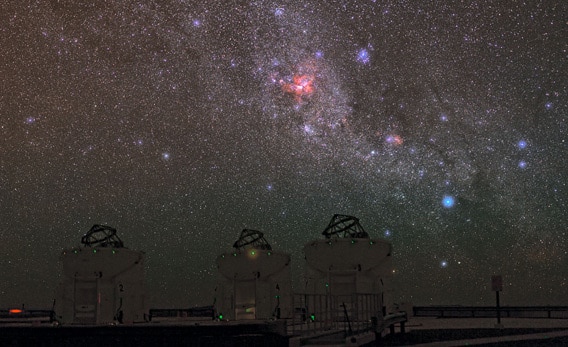Create a free profile to get unlimited access to exclusive videos, sweepstakes, and more!
The Southern Skies, Lit Like Neon

One of the things I love to do on the blog is post incredibly lush and beautiful photos of the night sky, then explain them. Itâs eye-candy and brain-candy. Except nourishing. OK, the candy analogy doesnât work so well, but still, check out this incredible shot of the southern sky taken by my friend Babak Tafreshi:
Thereâs a whole lot of awesome here. [Click to enkeelenate.]
What grabs your attention right away is the stunning starscape. This picture was taken in Chile, at a latitude of 24 degrees south. Many of the stars seen here never rise for those of us who live in the Northern Hemisphere; the Earth is forever in the way. Weâre looking in a direction toward the Milky Way, so we see lots of stars scattered aboutâitâs like looking toward the downtown of a city from a suburb.
Most of the stars you see here are part of the constellation Carina, representing the keel of a ship. The brightest star in the picture, though, the blue one on the right, is called Acrux, one of the stars in Crux, the famous Southern Cross. Crux is a kite-shaped figure, with Acrux at the top and the other three to the lower left.
Dominating the shot is the ruddy glow of the mighty Carina Nebula, a vast, sprawling complex of gas and dust so large, so massive, that itâs hard to describe, let alone grasp.
In this nebula are thousands upon thousands of stars, born from the chaos of swirling gas. Some of the most massive stars known call this nebula home, including Eta Carinae, a star with something like 100 times the mass of our Sunâthatâs near the theoretical upper limit of how massive a star can be. The more massive a star, the hotter and more energetic it is, and if Eta Car (as we in the know call it) were any bigger, it would tear itself apart. In 1843 it underwent a violent paroxysm that blasted our two lobes of material at incredible velocity, each with about as much mass as the Sun! Even from its distance of 7,500 light years, it briefly became one of the brightest stars in the sky.
The red color you see in the big picture is real: itâs from hydrogen, octillions of tons of it, set aglow by the ultraviolet light of those massive stars. They flood the gas with radiation, exciting the electrons in its atoms, making it glow in the same way a neon sign does. You can pick out smaller clumps of red hydrogen clouds as well, each lit in the same way by stars embedded inside them. Those stars have short lifetimes, living only a few million years at most. When they run out of fuel theyâll die, exploding as supernovae.
Then youâll really see those clouds glow. And blasted apart.
Only after you gawk at the celestial treasures in this picture will you notice the far more terrestrial foregroundâa trio of telescopes silhouetted against the sky. Thes are three of the four auxiliary telescopes for the gigantic (and prosaically named) Very Large Telescope. Each of these monsters sports a mirror more than 8 meters (25 feet) across! Not only that, using very a sophisticated technique called interferometry, the four can be combined, acting as a single, even larger telescope, capable of resolving small details in cosmic objects better even than Hubble can. Itâs an extremely powerful tool used by astronomers around the world.
Babak Tefreshi, who took this shot, is an accomplished astrophotographer. He works with The World At Night, a wonderful group trying to raise awareness of the beauty of the night sky. Although Iâve been writing about Babakâs work for years, I had the pleasure of meeting him in real life for the first time just a few days ago at the Arizona Astronomy and Science Expo. It was an honor to shake the hand of a man who has brought so much beauty literally down to Earth.
I love pictures like this. They combine the heavens and the Earth, and do it with the nice twist of showing us the very machines weâve built to help us understand the Universe we see in the picture. Weâre a part of all this, which means in a very real way, as Carl Sagan said, we are a way for the cosmos to know itself.


























